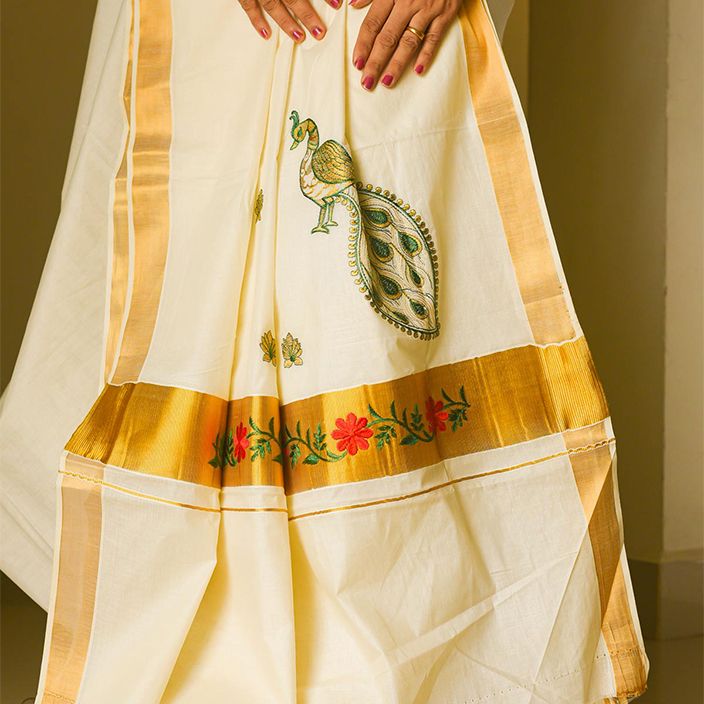For best prices and early deliveries, WhatsApp us at. 918488070070
Kerala
Located on the southwestern tip of the Indian subcontinent, Kerala is a state that lies between the Arabian Sea and the Western Ghats. With its importance in foreign trade and historically significant culture and traditions, the state is a hub of religion, art, and literature. It is neighboured by Tamil Nadu and Karnataka and is renowned for its mainly tropical climate. Kerala’s lush green forests, flourishing backwaters, and sacred temples are responsible for the booming tourism in the state. The state government has also labelled it as ‘God’s Own Country’ in an effort to attract more tourists. Considering its position in the global spice market, especially with the superior variety and quality of spices, Kerala was also reputed as the ‘land of spices’. Teeming with colour and flavour, this state has a lot to offer even as a multi-lingual, diverse, communal land.
Traditional Clothing In Kerala
Women
The women of Kerala traditionally dress in minimalistic clothes that accurately reflect their heritage. While they usually adorn a saree, their customary outfit is a two-piece set, ‘Mundum neriyathum’. Made with off-white or cream coloured handwoven cotton, ‘Mundum’ is simply a piece of cloth wrapped around the hip. ‘Neriyathum’ is also made using the same material but is placed over the left shoulder diagonally and tucked in at the waist. A golden (kasavu) or dyed border, known as the ‘kara’, is a common feature amongst both components of the set and matching blouse. This set reflects the basic look and essence of a regular saree.
Considering the growing demand for the two-piece set, the ‘set saree’ or ‘Kerala saree’ has also become a desirable garment. This new type of saree is worn just like a normal one, but its length is only five and a half meters. The colour and design of the set saree stay true to the main traditional attire.
Young teenage girls can be spotted wearing the ‘pattu pavada’, consisting of a silk blouse and long skirt. However, they only wear it during special occasions like weddings, religious ceremonies, or festivals. The reason for this is a general sense of preference of the age group; they are fond of casual and comfortable wear.
Men
The men of Kerala conventionally wear a white cloth around their waist, ‘mundu’. This cloth is embellished with a border called ‘kara’ found in many colours but usually golden. Mundu is very similar to a lungi and dhoti, as worn by men in other Indian states. For fancy occasions, silk is used as the fabric, while the kara border often has beads, charms, and other ornaments embroidered onto it. A ‘melmundu’ is the local term for the top wear, which is worn similarly to a towel. It is laid across a man’s shoulders. In more recent times, a white shirt is not an uncommon garment worn.
The mundu can be transformed into a garment that is similar to a skirt by tucking the bottom end of it into their waist. This is a technique usually followed during physical activities like farming, ploughing, etc.
Both pieces of this traditional set are a fundamental part of male Keralites’ wardrobes for both daily wear and special events.
Staple Jewellery & Accessories
Inspired by the state’s exquisite temples and fascinating mythology, Kerala’s jewellery is etched with a creative portrayal of gods and goddesses. Every piece of jewellery is an authentic depiction of their rich and affluent culture.
To begin with, the ‘Manga Mala’ is a necklace with mango-shaped charms, while ‘Mulla Motu’ is a necklace adorned with a chain of jasmine petals. This necklace has two featured designs as a bridal essential - gold jasmine petals and a combination of jasmine petals with spiritual gemstones. ‘Pulinakham Mala’ is embellished with stones shaped as the nails of a tiger. The ‘Karimani Mala’ is a South Indian mangalsutra worn by married women. It is made with gold and consists of a series of black and gold beads. ‘Kasu Mala’ refers to a necklace of coins carved with the figure of Goddess Lakshmi. Crafted with emeralds or imitation green gemstones, the ‘Palakka Mala’ resembles a leaf with a gold outline. As one of the oldest jewellery pieces of Kerala, the ‘Nagapada Thali’ looks like a snake’s hood with emeralds strung together on a gold chain.
‘Pathakam’ is a beautiful all-gold pendant and chain worn traditionally by South Indian women. Next, the ‘Poothali’ is a necklace that features designs inspired by nature, like flowers and leaves.
An anklet, ‘Kolusu’, can be made with either silver or gold. Traditional Dress of Kerala Women and young girls adorn this jewellery for weddings, religious events and festive celebrations in Kerala. The ‘jhimkis’ are a cultural dresses and ornament worn by brides that resemble bell-shaped earrings. Forged of two types - studs and danglers, these earrings are worn all over the country. They are available in a variety of designs, materials, and colours. Yet another bridal and heritage essential, the ‘Elakkathali’ is a heavy gold choker with intricate designs worn around the neck. Lastly, ‘Vanki’ refers to a traditional Keralan bajuband, an armlet. Embossed with rubies, rose-cut diamonds, and emeralds, a lotus petal or figures of deities are created within this jewellery.
Fashion Evolution
Kerala has taken to change very well, of which the high rate of literacy can be used as a reason. The citizens understand the need for development as well as preserving long-standing traditions. One of these traditions includes wearing white or cream coloured garments. It represents their nature — pleasant, easy-going, and straightforward. Elegance, simplicity, and purity are also factored in when it comes to the colour.
During regional festivals like Onam and Vishu, everyone in a typical Keralite family adorns their respective traditional attires. Be it the younger generation or the older age group, the respect for their culture knows no limits.
